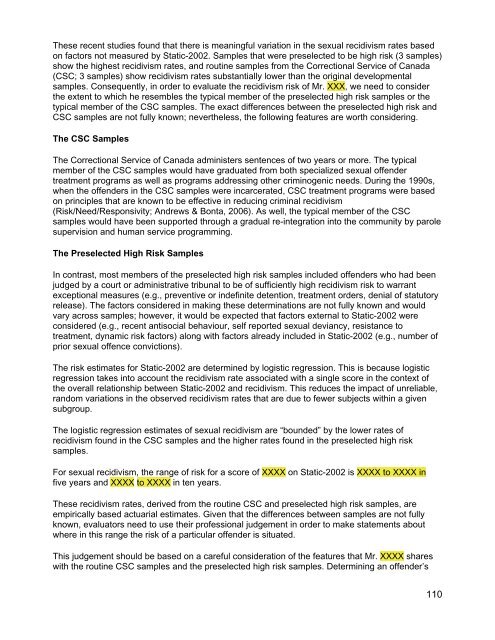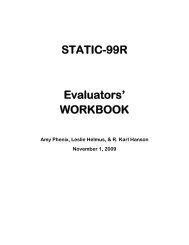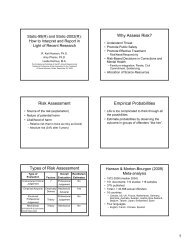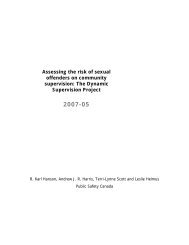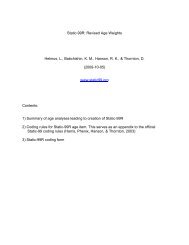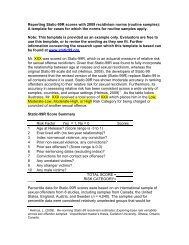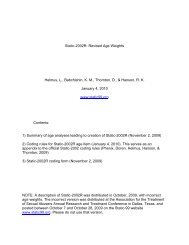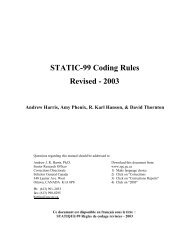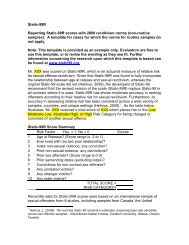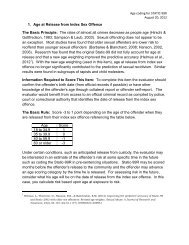Static-2002 coding rules (2009) - Static-99
Static-2002 coding rules (2009) - Static-99
Static-2002 coding rules (2009) - Static-99
You also want an ePaper? Increase the reach of your titles
YUMPU automatically turns print PDFs into web optimized ePapers that Google loves.
These recent studies found that there is meaningful variation in the sexual recidivism rates based<br />
on factors not measured by <strong>Static</strong>-<strong>2002</strong>. Samples that were preselected to be high risk (3 samples)<br />
show the highest recidivism rates, and routine samples from the Correctional Service of Canada<br />
(CSC; 3 samples) show recidivism rates substantially lower than the original developmental<br />
samples. Consequently, in order to evaluate the recidivism risk of Mr. XXX, we need to consider<br />
the extent to which he resembles the typical member of the preselected high risk samples or the<br />
typical member of the CSC samples. The exact differences between the preselected high risk and<br />
CSC samples are not fully known; nevertheless, the following features are worth considering.<br />
The CSC Samples<br />
The Correctional Service of Canada administers sentences of two years or more. The typical<br />
member of the CSC samples would have graduated from both specialized sexual offender<br />
treatment programs as well as programs addressing other criminogenic needs. During the 1<strong>99</strong>0s,<br />
when the offenders in the CSC samples were incarcerated, CSC treatment programs were based<br />
on principles that are known to be effective in reducing criminal recidivism<br />
(Risk/Need/Responsivity; Andrews & Bonta, 2006). As well, the typical member of the CSC<br />
samples would have been supported through a gradual re-integration into the community by parole<br />
supervision and human service programming.<br />
The Preselected High Risk Samples<br />
In contrast, most members of the preselected high risk samples included offenders who had been<br />
judged by a court or administrative tribunal to be of sufficiently high recidivism risk to warrant<br />
exceptional measures (e.g., preventive or indefinite detention, treatment orders, denial of statutory<br />
release). The factors considered in making these determinations are not fully known and would<br />
vary across samples; however, it would be expected that factors external to <strong>Static</strong>-<strong>2002</strong> were<br />
considered (e.g., recent antisocial behaviour, self reported sexual deviancy, resistance to<br />
treatment, dynamic risk factors) along with factors already included in <strong>Static</strong>-<strong>2002</strong> (e.g., number of<br />
prior sexual offence convictions).<br />
The risk estimates for <strong>Static</strong>-<strong>2002</strong> are determined by logistic regression. This is because logistic<br />
regression takes into account the recidivism rate associated with a single score in the context of<br />
the overall relationship between <strong>Static</strong>-<strong>2002</strong> and recidivism. This reduces the impact of unreliable,<br />
random variations in the observed recidivism rates that are due to fewer subjects within a given<br />
subgroup.<br />
The logistic regression estimates of sexual recidivism are “bounded” by the lower rates of<br />
recidivism found in the CSC samples and the higher rates found in the preselected high risk<br />
samples.<br />
For sexual recidivism, the range of risk for a score of XXXX on <strong>Static</strong>-<strong>2002</strong> is XXXX to XXXX in<br />
five years and XXXX to XXXX in ten years.<br />
These recidivism rates, derived from the routine CSC and preselected high risk samples, are<br />
empirically based actuarial estimates. Given that the differences between samples are not fully<br />
known, evaluators need to use their professional judgement in order to make statements about<br />
where in this range the risk of a particular offender is situated.<br />
This judgement should be based on a careful consideration of the features that Mr. XXXX shares<br />
with the routine CSC samples and the preselected high risk samples. Determining an offender’s<br />
110


